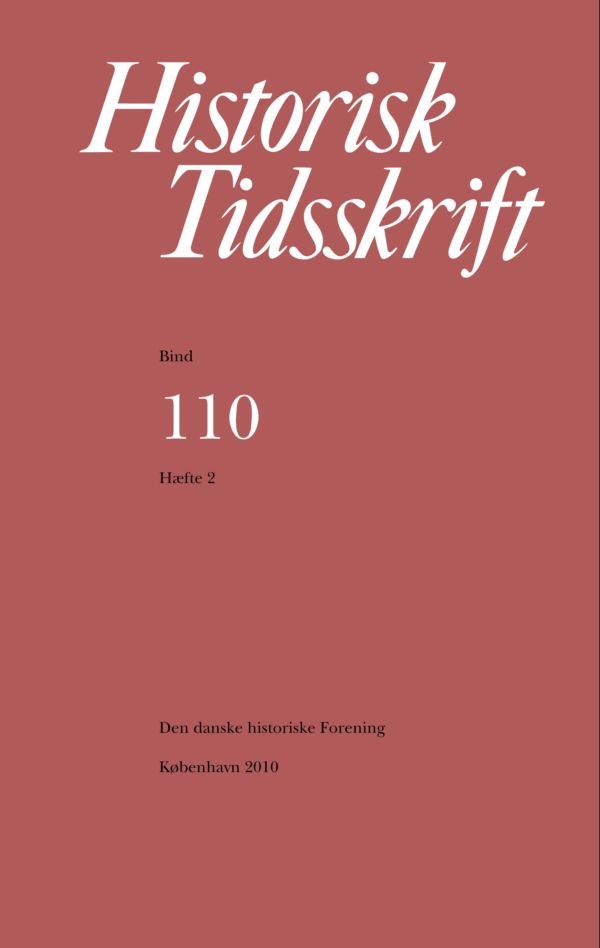Dansk radikalkonservatismes sekulærreligion
Resumé
Danish Radical Conservatism as Secular ReligionDanish Radical Conservatism in the interwar period found its most wellreasoned and sophisticated expression in the periodical Det nye Danmark [»New Denmark«], published from 1928 through 1937. The first three volumes make up the source material of this article. Those years witnessed the formation of a new ideological tendency that represented an alternative to pragmatic, mainstream Conservatism. Supporters of the latter accepted continuous modernization of society, even according to a liberal and social reformoriented pattern, so long as renewal was gradual and moderate. Responsible compromise, especially between economic interest groups, was a guiding principle for the Conservative People’s Party, successor – by change of name in 1916 – to the party organization and parliamentary group formerly known as »the Right«. The new Radical Conservatives reacted against this approach by dissociating themselves from the class-based egoism which, according to their view, lay at the root of even conservative-liberal political reasoning. They desired a collective national and religious resurrection based on spiritual concord and the monarchy as the core institution which embodied the bonds between past and present Denmark. The nation was a sacred unity and thus the purpose and meaning of political activity. In the present article Radical Conservative ideas are discussed within the theoretical framework established by Emilio Gentile, Marcela Cristi and Robert Bellah. Here, secular religion is the common denominator while civil and political religion are main variants. Civil religion involves a set of values and symbols which support citizens’ identification with and loyalty towards a liberal democracy. The underlying ideology is not necessarily socially neutral, yet neither is it repressive. This, by contrast, is an inherent feature of political religion. This phenomenon typically appears in authoritarian systems and is particularly linked with Fascism. The ideology is invasive vis-à-vis the individual: strongly normative and aiming at the creation of a »New Man«. Not nearly all Danish conservative intellectuals belonging to the New Denmark circle were all-out radicals. A few were ’Blood and Soil’ romanticists, and others were seeing positive elements in Fascist ideology and politics. The majority, though, achieved important positions within the Conservative party, adapted a pragmatic stance in day-to-day politics and rejected the right wing radicalism of the later 1930s. Nonetheless, the attitude of the group falls within the category of secular religion, or is at least bordering on it. More than anywhere else this was evidenced by the issue of faith. Leading moderate figures, notably New Denmark editor Alfred Bindslev, a university trained theologian and Member of Parliament, held the opinion that the existential and moral doctrines of Christianity were of universal validity and possessed such authority that even the results and overall quality of a nationalconservative regime were to be measured by their yardstick. Some scholars have interpreted this as if religion,not the nation, were the stable core value in the minds of Radical Conservatives. The present article, however, argues that the gospel of Christianiy was reinterpreted and instrumentally adapted to fit in as a cogwheel – albeit a central one – in a secular-religious machinery. Even though the charismatic and popular leader of the Conservatives, John Christmas Møller, contemplated the Radical Conservatives in a way that signalled dissociation, if not outright contempt, their ideas remained influential during the 1930s, but after the war they evoked no response. Later on, the movement was presented in a rather ironic light even by its old stalwarts.Downloads
Publiceret
Citation/Eksport
Nummer
Sektion
Licens
Ophavsret til bidrag i Historisk Tidsskrift tilhører forfatterne og Den danske historiske Forening som udgiver af Historisk Tidsskrift. For illustrationer gælder den ophavsret, som står anført i billedteksten. Ophavsretslovens almindelige bestemmelser gælder, hvilket vil sige, at ophavsretten gælder i 70 år efter forfatterens død. Bidrag i Historisk Tidsskrift må derfor, med forbehold for en ”moving wall” på tre år, frit downloades, læses, gemmes, anvendes og citeres (med kildeangivelse) i privat og videnskabelig sammenhæng, men de må ikke helt eller delvis genudgives af tredjepart, heller ikke i redigeret form, uden tilladelse fra forfatterne og Den danske historiske Forening. Henvendelse skal i så fald rettes til Historisk Tidsskrifts redaktion på histtid@hum.ku.dk.





